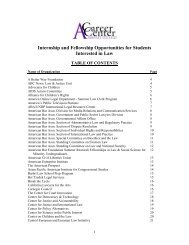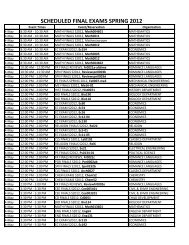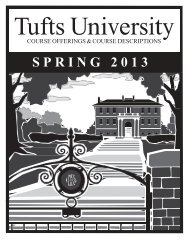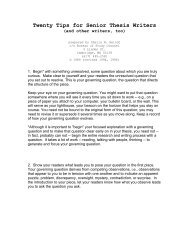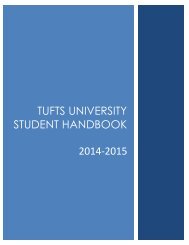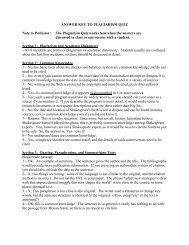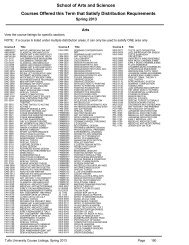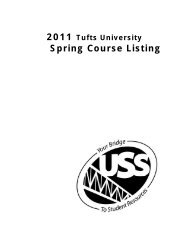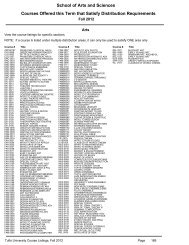2013â2014 The Bulletin - USS at Tufts - Tufts University
2013â2014 The Bulletin - USS at Tufts - Tufts University
2013â2014 The Bulletin - USS at Tufts - Tufts University
Create successful ePaper yourself
Turn your PDF publications into a flip-book with our unique Google optimized e-Paper software.
Architectural Studies ><br />
Art and Art History ><br />
UNDERGRADUATE MINOR ProgrAMS<br />
Architectural Studies<br />
<strong>The</strong> Department of Art and Art History offers a<br />
minor in architectural studies for both liberal arts<br />
and engineering students consisting of five courses:<br />
Art History 1 Art History to 1700<br />
Art History 8 Introduction to Architecture, 1400 to the<br />
Present<br />
Studio Art (FAM 22; or 20, 23, 26; or DR 21)<br />
Engineering 5, 23, 39, or 80; or Engineering<br />
Psychology 61; or Engineering Science 5, 18, 25, or 27<br />
Upper-level architectural history class (FAH 115,120, 123,<br />
125, 126, 127, 190, 191, 195, 196, 290, 192 [architecture];<br />
CE 120)<br />
Note: Engineering students minoring in architectural<br />
studies replace the engineering requirement with an<br />
approved course from the major’s disciplinary areas A,<br />
B, or C (see above).<br />
Architectural Engineering<br />
<strong>The</strong> Department of Civil and Environmental<br />
Engineering offers a minor in architectural<br />
engineering for students in the College of Liberal<br />
Arts. <strong>The</strong> faculty advisor for this minor is Professor<br />
Masoud Sanayei.<br />
Art and Art History<br />
Professor Peter Probst, Chair, research area: African art,<br />
memory and monuments, historic preserv<strong>at</strong>ion, cultural<br />
property, theories of value, historiography<br />
Professor Andrew McClellan, Director of Museum Studies,<br />
research area: baroque-rococo art, museum history and theory<br />
Associ<strong>at</strong>e Professor Daniel Abramson, Director of<br />
Architectural Studies, research area: architecture from<br />
Renaissance to contemporary, Europe and America<br />
Associ<strong>at</strong>e Professor Cristelle Baskins, research area:<br />
Italian Renaissance art, secular painting and narr<strong>at</strong>ive, and<br />
gender and women’s studies<br />
Associ<strong>at</strong>e Professor Ikumi Kaminishi, Director of<br />
Undergradu<strong>at</strong>e Studies, research area: Asian art and<br />
architecture, Buddhist painting, narr<strong>at</strong>ive studies<br />
Associ<strong>at</strong>e Professor Christina Maranci, Director of<br />
Gradu<strong>at</strong>e Studies, research area: Arthur H. Dadian and Ara<br />
Oztemel Associ<strong>at</strong>e Professor of Armenian Art and architecture,<br />
Byzantine art and architecture<br />
Associ<strong>at</strong>e Professor Karen Overbey, research area:<br />
Medieval art and architecture, relics and reliquaries, early Irish<br />
art—on leave 2013–14<br />
Associ<strong>at</strong>e Professor Eric Rosenberg, research area:<br />
American art, modern and contemporary art<br />
Associ<strong>at</strong>e Professor Adriana Zavala, Transfer of Credit<br />
Represent<strong>at</strong>ive, research area: modern and contemporary<br />
L<strong>at</strong>in American art, art of Mexico, and gender and women’s<br />
studies<br />
Assistant Professor Eva Hoffman, research area: Islamic<br />
art and architecture, portable arts—on leave 2013–14<br />
Assistant Professor Jeremy Melius, research area: Modern<br />
European art 1850–1960<br />
SECONDARY APPOINTMENTS:<br />
Susan Lush, Associ<strong>at</strong>e Dean of Academic Affairs, School of<br />
the Museum of Fine Arts<br />
P<strong>at</strong>rick Carter, <strong>Tufts</strong> Studio Arts Coordin<strong>at</strong>or, School of the<br />
Museum of Fine Arts<br />
Amy Ingrid Schlegel, Director, <strong>Tufts</strong> <strong>University</strong> Art Gallery;<br />
Cur<strong>at</strong>orial studies<br />
Our program aims to provide students with a<br />
critical and globally informed understanding of the<br />
history of art and visual culture. Understanding the<br />
sources, aesthetics, and significance of images th<strong>at</strong><br />
people use to communic<strong>at</strong>e—whether in the<br />
confined world of art or beyond—is crucial for<br />
anyone wanting to play an active part in society.<br />
Students taking art history classes can expect to<br />
learn how to look <strong>at</strong> and write about works of art.<br />
Yet they will also learn about the historical and<br />
trans-cultural contexts in which visual works<br />
emerge and oper<strong>at</strong>e. Thus, students taking classes<br />
in art history will find themselves immersed in<br />
questions of politics, identity, religion, economics,<br />
mobility, communic<strong>at</strong>ion, and many other exciting<br />
issues.<br />
As a humanistic discipline, the history of art<br />
emphasizes scholarly investig<strong>at</strong>ion and critical<br />
analysis over technical training. However, majors<br />
are encouraged to take studio courses as part of<br />
their program and to take advantage of <strong>Tufts</strong>’<br />
affili<strong>at</strong>ion with the School of the Museum of Fine<br />
Arts.<br />
UNDERGRADUATE ProgrAM<br />
<strong>The</strong> department offers the bachelors of art degrees<br />
in art history and in architectural studies.<br />
Art History Concentr<strong>at</strong>ion<br />
For the bachelor of art degree in art history, ten<br />
courses are required for the major: Art History 1, 2<br />
and 100; two courses pre-1700; two courses<br />
102



